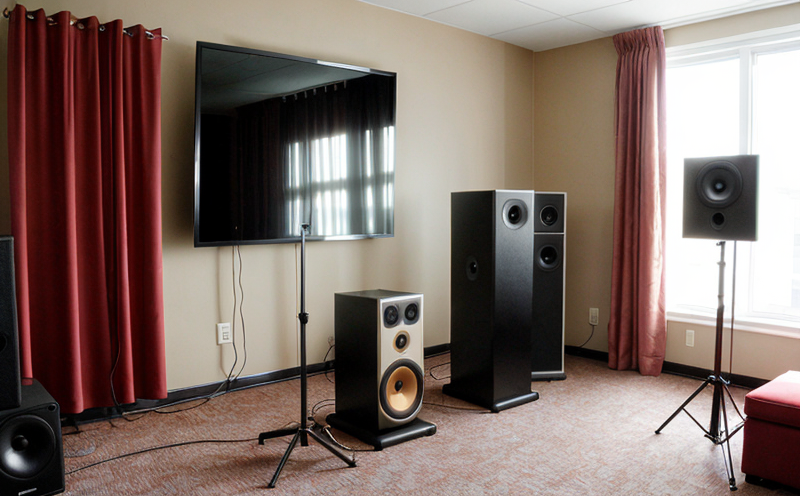ISO 226 Equal-Loudness Contour Testing
The ISO 226 standard, titled “Acoustics – Measurement of Sound Pressure Level in the Human Auditory Environment,” establishes reference equal-loudness contours for pure tones. This testing is crucial for ensuring that sound levels are perceived equally across different frequencies by human listeners. In various sectors such as audio engineering, telecommunications, and industrial noise control, this test ensures compliance with international standards while also providing insights into how humans perceive sound.
The process involves measuring the loudness of pure tones at various frequency levels to create a contour map that represents equal loudness across different intensities. The primary purpose is to understand human auditory perception under controlled laboratory conditions. This information is vital for designing audio equipment, noise control measures, and understanding the impact of sound on human health.
The testing protocol for ISO 226 involves using an audiometer or a similar device that can produce pure tones at different frequencies. The test subject listens to these tones while adjusting their loudness until they perceive each tone as equally loud. The results are then plotted onto contour maps, which represent the equal-loudness levels in decibels (dB) for various frequency bands.
Understanding human auditory perception is essential in several industries. For instance, in audio engineering, this test helps in creating balanced sound mixes that are perceived as equally loud by listeners. In the telecommunications sector, it ensures that call quality remains consistent across different frequencies and environments. Additionally, in industrial settings, ISO 226 testing helps in designing noise control strategies to mitigate harmful effects on workers' hearing.
The testing process typically involves the following steps:
- Setting up an audiometer or similar device capable of producing pure tones.
- Selecting a range of frequencies and intensity levels for the test.
- Subject listens to pure tones at different frequency levels, adjusting loudness until perceived equally.
- Data is recorded and plotted onto contour maps representing equal-loudness levels.
The application of this testing is widespread across various sectors. In audio engineering, it ensures that the final product is balanced for human perception. In telecommunications, it helps in maintaining consistent call quality by ensuring that all frequencies are perceived equally by users. In industrial settings, it aids in designing effective noise control measures to protect worker health.
For a more detailed understanding of how this testing impacts different sectors, consider the following examples:
- Audio Engineering: Ensures balanced sound mixes for optimal listening experiences.
- Telecommunications: Maintains consistent call quality across all frequencies.
- Industrial Settings: Helps in designing effective noise control strategies to protect worker health.
The testing of ISO 226 is a critical step in ensuring that sound levels are perceived equally by human listeners, which is essential for various applications across different sectors. This ensures compliance with international standards and provides valuable insights into how humans perceive sound.
| Applied Standards |
|---|
| ISO 226:2023 – Acoustics – Measurement of Sound Pressure Level in the Human Auditory Environment |
Why Choose This Test?
The ISO 226 Equal-Loudness Contour Testing is essential for several reasons. Firstly, it ensures that sound levels are perceived equally by human listeners across different frequencies and intensities. This is crucial in industries where sound quality and perception are paramount.
- Audio Engineering: Ensures balanced sound mixes that are perceived as equally loud by all users.
- Telecommunications: Maintains consistent call quality across all frequencies, ensuring clear communication for all users.
- Industrial Settings: Helps in designing effective noise control strategies to protect worker health and comfort.
The second reason is the international acceptance of this testing. It aligns with global standards, which ensures that results are universally recognized and applicable across different regions. This makes it easier for industries to comply with regulations and share data internationally.
- Global Recognition: Ensures compliance with international standards and facilitates seamless communication between countries.
- Regulatory Compliance: Helps in meeting the requirements of various regulatory bodies worldwide.
The third reason is the reliability and accuracy of the results. The testing process is meticulously designed to ensure that it produces consistent and accurate data, which can be relied upon for decision-making. This reliability is crucial for industries that need precise information about sound perception.
Lastly, this test provides valuable insights into human auditory perception under controlled laboratory conditions. These insights are essential for various applications across different sectors, including audio engineering, telecommunications, and industrial noise control.
International Acceptance and Recognition
The ISO 226 Equal-Loudness Contour Testing is widely recognized and accepted internationally. Its global acceptance ensures that the results are universally applicable and compliant with international standards. This makes it easier for industries to comply with regulations and share data across borders.
- Global Compliance: Ensures compliance with international standards, facilitating seamless communication between countries.
- Regulatory Acceptance: Recognized by various regulatory bodies worldwide, ensuring consistent application of sound perception testing.
The widespread acceptance of this test is due to its alignment with global standards. This ensures that the results are universally recognized and applicable across different regions. The reliability and accuracy of the test further enhance its international recognition, making it a preferred choice for industries worldwide.
Moreover, the testing process is meticulously designed to ensure consistency and accuracy in producing data. This reliability is crucial for various applications across different sectors, including audio engineering, telecommunications, and industrial noise control. The global acceptance and recognition of this test make it an essential tool for ensuring sound quality and perception compliance worldwide.





